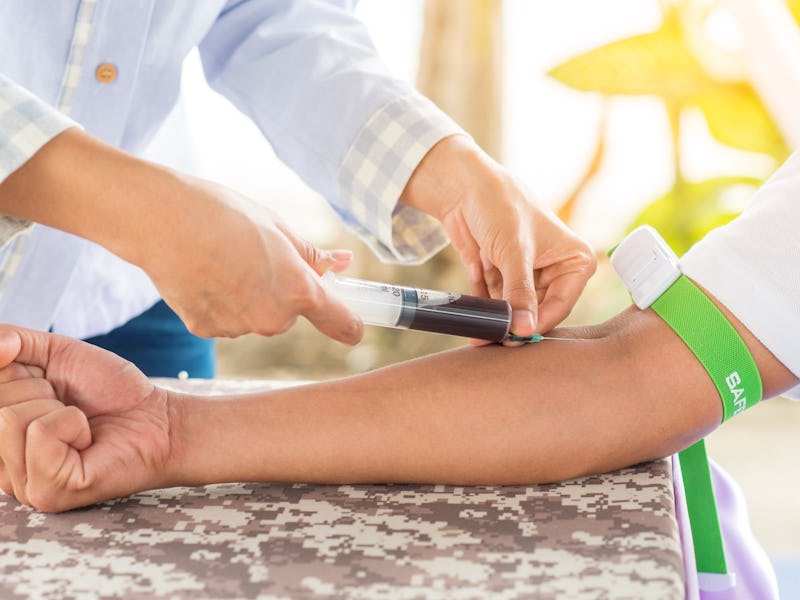Scientists want to let this robot suck your blood -- for medical purposes only
This blood-sucker is better at drawing blood than human doctors in some cases.

Bloodsucking robot is probably one of the last phrases you ever want to read, but scientists say that such a robot could actually help extend your life instead of shortening it by drawing your blood at a doctor's office.
Getting your blood drawn (medically known as "veinpuncture") is one of medicine's most common procedures which, along with IV insertion, occurs over 1.4 billion times yearly in the United States alone according to CDC data from 2016. While these procedures require less technical rigor than, say, heart surgery, different patient physiology and practitioner error can lead to extended or failed procedures and can drive up medical costs as a result -- particularly in patients with difficult vein access (DVA.) To help improve this process for both health care providers as well patients, researchers have designed a hand-held, ultrasound-guided robot capable of locating veins and drawing blood from a patient.
The study, published last December in the journal Technology, looked at how this device could improve blood drawing accuracy and success in an experimental group of 31 volunteer patients. While 25 participants were determined to have "normal" veins, six of the participants were considered to have DVA, meaning their veins were either difficult to locate or rolled away from the needle upon insertion. The device itself was designed to work equally well for both groups and was composed of an ultrasound probe used to identify blood vessels for insertion and an electromagnetic needle loader and manipulator.
A prototype of the device being demonstrated on a human patient.
In trials, the participants would first have their veins located by a physician and then have the device manually positioned over their forearm. The ultrasound probe would then be used to determine vessel location, which was relayed to the needle manipulator to ensure the insertion point would be accurate. The needle would then be inserted by the device and extract 5 milliliters of blood from the participant. The authors write in the study that the procedure was considered a success if they were able to insert the needle and draw the blood within two tries.
The authors report in the study that they had an overall success rate of 87 percent for all 31 patients and a 97 percent rate for the 25 patients without DVA. For both groups, the procedures took between a minute and a half and two minutes. The authors write that these results for non-DVA patients were on par with clinical results (which have about 90 percent accuracy) and above par for DVA results (which have about 60 percent accuracy.)
The study's first author and biomedical engineering doctoral student Rutgers University-New Brunswick, Josh Leipheimer, said in a statement that these results show promise for how such a device could improve the blood drawing experience.
"A device like ours could help clinicians get blood samples quickly, safely and reliably, preventing unnecessary complications and pain in patients from multiple needle insertion attempts," said Leipheimer.
While the results of the study were promising, they weren't perfect. The authors write that most of the errors came as a result of blood vessels rolling way from the insertion point when the needle approached. In the future, they hope to improve this design flaw by using the ultrasonic probe to better predict when the blood vessel might roll and change the angle of the needle to account for the movement.
Beyond its application as a robotic phlebotomist, the authors also write that this technology could be used as a framework for other intravenous procedures as well, including IV and catheter placement. While such devices wouldn't replace human physicians, they could alleviate the burden as well as help ensure accuracy and ease of the procedures.
Abstract: Obtaining venous access for blood sampling or intravenous (IV) fluid delivery is an essential first step in patient care. However, success rates rely heavily on clinician experience and patient physiology. Difficulties in obtaining venous access result in missed sticks and injury to patients, and typically require alternative access pathways and additional personnel that lengthen procedure times, thereby creating unnecessary costs to healthcare facilities. Here, we present the first-in-human assessment of an automated robotic venipuncture device designed to safely perform blood draws on peripheral forearm veins. The device combines ultrasound imaging and miniaturized robotics to identify suitable vessels for cannulation and robotically guide an attached needle toward the lumen center. The device demonstrated results comparable to or exceeding that of clinical standards, with a success rate of 87% on all participants (n = 31), a 97% success rate on nondifficult venous access participants (n = 25), and an average procedure time of 93 ± 30 s (n = 31). In the future, this device can be extended to other areas of vascular access such as IV catheterization, central venous access, dialysis, and arterial line placement.